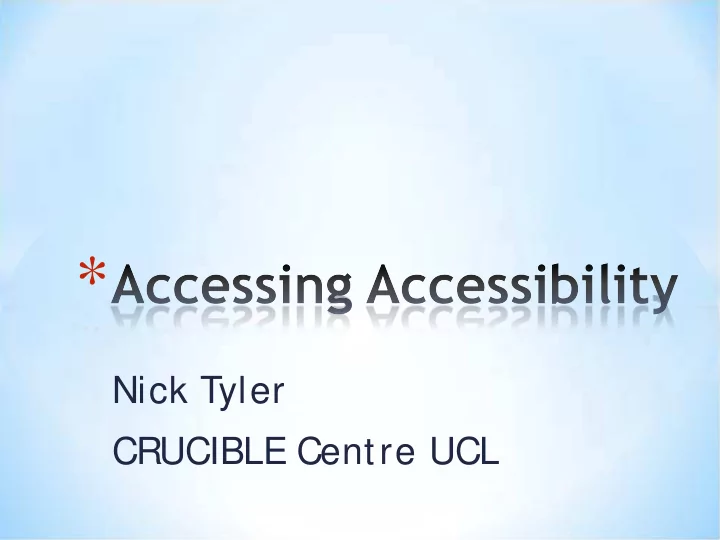

* Nick Tyler CRUCIBLE Centre UCL
* What are we really aiming for? * S ociological * Medical * Technological * Personal *
* Condit ion-cent red * Fix t he condit ion * Easier t o put similar condit ions in t he same place * Treat / cure * Care * Opt imise t reat ment (s) *
* Environment -cent red * Political/ social/ economic * At t it udinal * S elf * Others * Treat environment * Opt imise t reat ment *
* Neit her put s t he person at t he cent re * S ome t hings require medical t reat ment * S ome t hings require environment al t reat ment * Most t hings require bot h * Places t reat ment at t he cent re rat her t han t he person * How do we know which t reat ment t o apply? * What happens when different people require conflict ing t reat ment s? *
* What does t he person want t o do? * What do t hey need in order t o do it ? * What does t hat imply about t he environment ? * What does t hat imply about t he person? *
* Activity Going to the shops - Travel along footway Tasks - Get on bus - Enter into shop Capabilities Required Provided < If Person + Environment wheelchair+ attendant
The Capability Model in detail Attendant-Propelled Wheelchair System Self-Propelled Wheelchair System (APWS) (SPWS) Person Wheelchair Person (Attendant) (occupant) Activity Task Environment Capabilities Key Required capabilities Provided capabilities Fixed Capabilities
* Catherine Holloway
* * Footways allow people to access services and other transport options * Crossfalls are present to aid water drainage from 2 % footways * There is agreement worldwide that 2.0% to 2.5% gradient is acceptable for wheelchair users
Wheelchair Types Attendant Self 34% 52% Powered Unknown 10% 1% Other 3% S apey, S tewart, Donaldson .” The S ocial Implications of Increases in Wheelchair Use”
* * S et-up footways with different crossfall gradients * Measure provided capabilit ies by estimating * How much they deviated from a straight line * Their maximum push strength * The forces used to start the wheelchair, * The work used to keep the wheelchair moving * The forces used to stop the wheelchair
* Dashed line showing straight path Lane width Start/Finish line * 3 lanes 2.4 m wide x 10.8 m long * 0% , 2.5% & 4% * Concrete interlocking paving stones
* Upslope Downslope Would expect: Would expect: decreased increased force with force/ braking with increased crossfall increased crossfall
* Fz Ft Fy Fx *
* S tandard NHS UK issue wheelchair for attendant propulsion 3-dimensional forces Rear wheel velocity Total weight of wheelchair, equipment & dummy = 104kg
Guidelines taken from Snook & Ciriello 1991
Guidelines taken from Snook & Ciriello 1991
Guidelines taken from Snook & Ciriello 1991
* Managing t o t ravel along a normal foot way is a challenge * Emphasis in t reat ment and research on t he person in t he wheelchair * At t endant propulsion is less st udied * Many (most ? ) at t endant s are older people * Qualit y of life is compromised for bot h t he person in t he wheelchair and t he person behind it *
*
* Falls are a big problem * Only a tiny fraction of incidents are presented in hospital * Costs immense but hidden (upper femur fracture costs the NHS ~£1.5bn/ year) * Psychological issue probably greater than the physical problems * Affects older people a lot * S o why does a fall occur? *
Cognitive/ S ensory physiological Physical capability Neurological capability capability capability Perceive the obstacle Lift the leg The brain recognises the Calculate the required The obstacle obstacle and instructs movement and the correct the eyes to look out for physiological stimulus for the the potential danger movement … recalculate and adj ust them during the approach 300-500 msec 2-3 sec
* How many st eps per st umble? * We make 10,000 st eps per day so t he special ingredient for a fall is a very rare and highly changeable beast * S t art ing from t he model j ust described, we can see t hat a lot of t hings precede t he encount er wit h an obst acle and we are now looking t o see if we can begin t o underst and t hese. *
* We need t o underst and t he mechanisms t hat keep us upright in order t o underst and t he possible ways t o help * S erious problem for older people – even t hose who do not fall * Falling in moving vehicles? *
* Complex messy problems * Mult idisciplinary approaches * Person-cent red * Be clear how t he person-environment combinat ion can be managed * Ask awkward quest ions * what about conflicting needs? *
* How do we ensure t hat t he desired act ivit ies are st ill possible? * How do we underst and how t o apply t he underst anding of t he phenomena t o t he real world scale? * What do we really mean by ‘ assist ive t echnology’ ? * Do int ervent ions make t hings worse? *
Recommend
More recommend